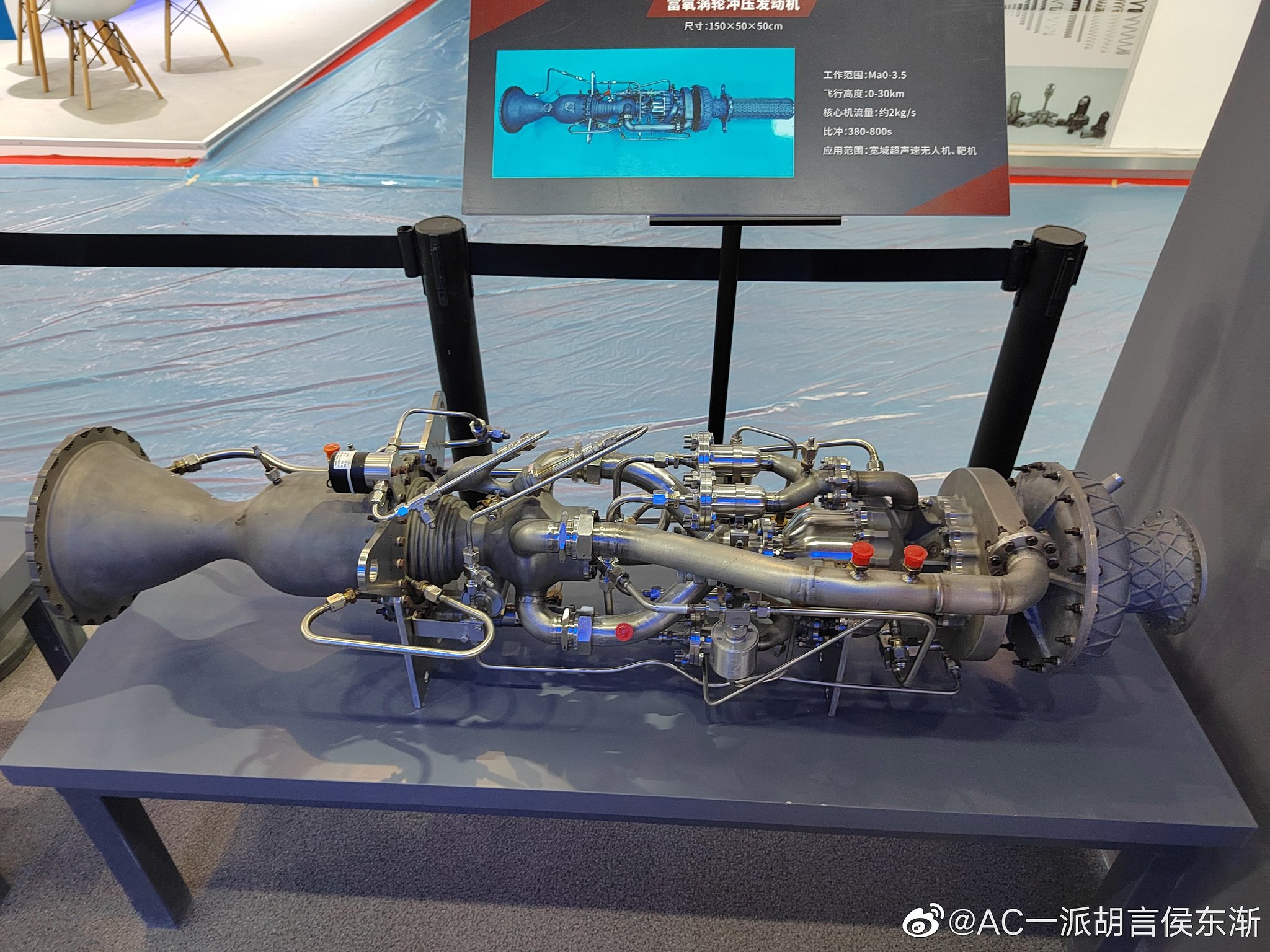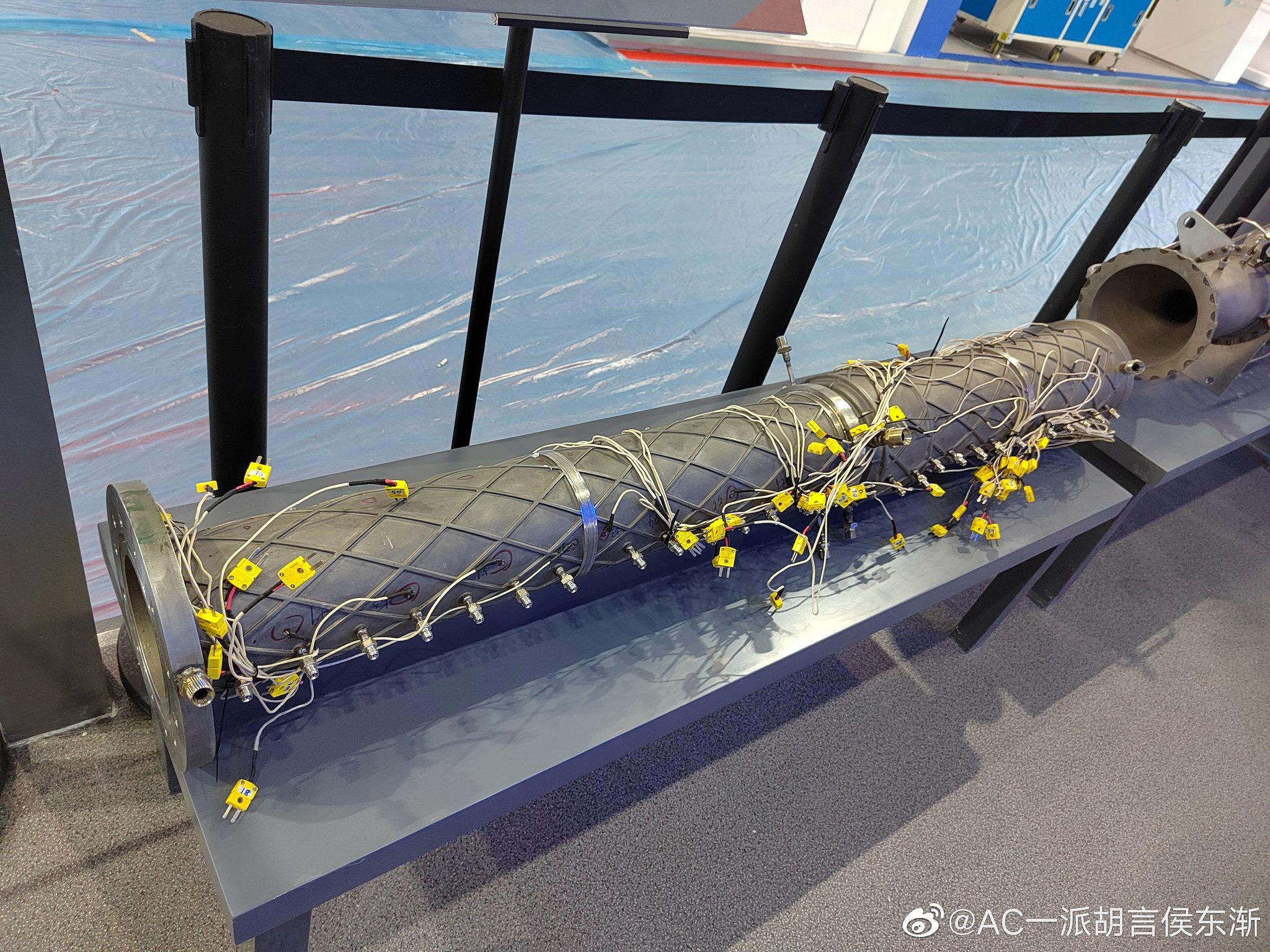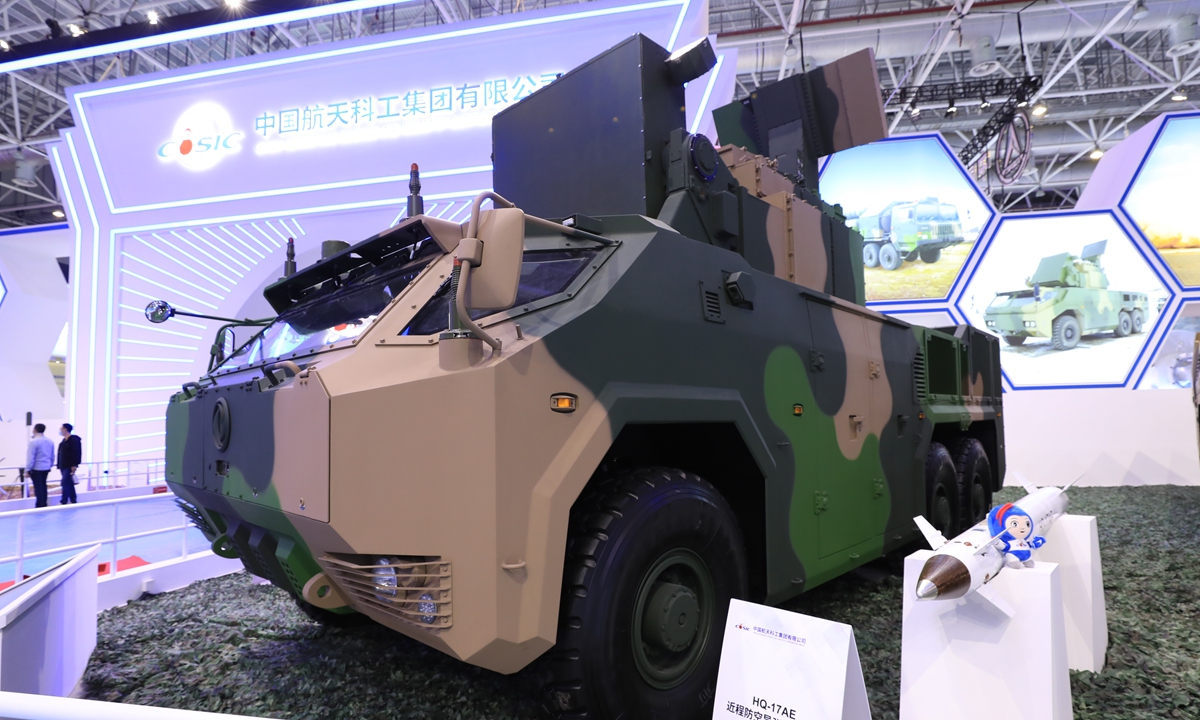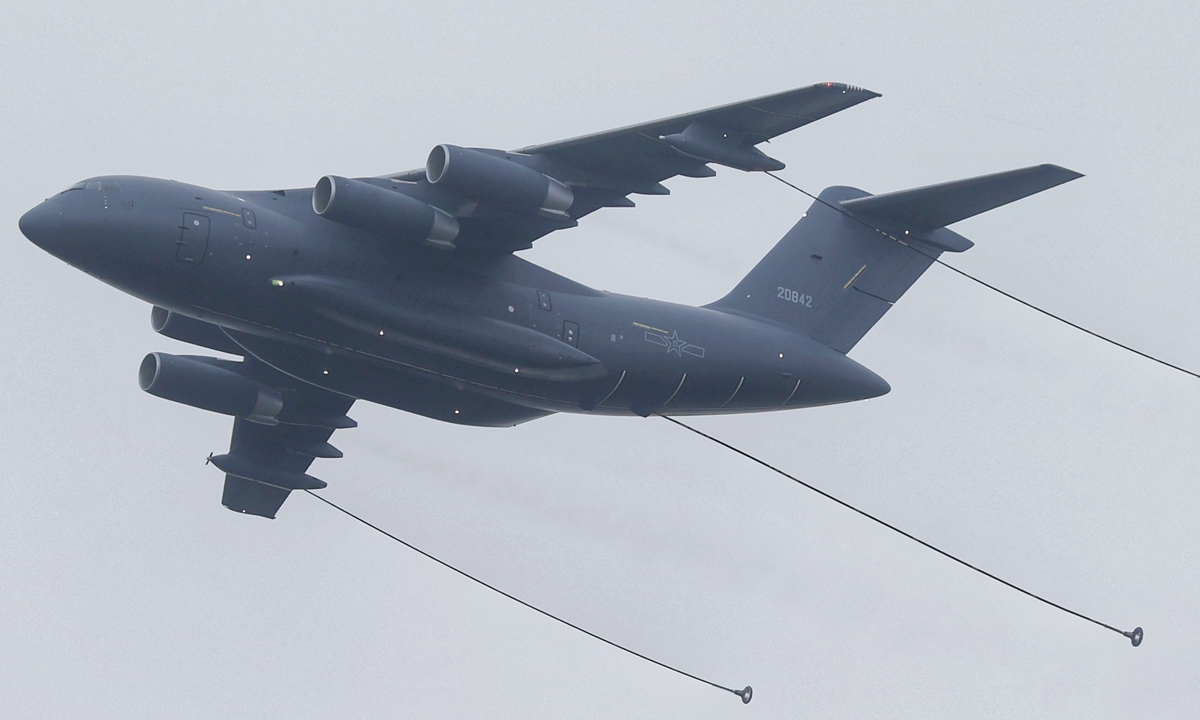You are using an out of date browser. It may not display this or other websites correctly.
You should upgrade or use an alternative browser.
You should upgrade or use an alternative browser.
Zhuhai Airshow 2022
- Thread starter Blitzo
- Start date
Turboramjet for supersonic UAVs and target drones.


You probably know that, but just clarify for others members. These are the engines standing next to MD-22. It is highly likely that they are for MD-22 and probably MD-21. The turbo-ram takes off and reach m3.5, the scramjet takes over up to m8.Scramjet for hypersonic missiles and planes. Operating envelope mach 4 to 7.


Maybe you should consider moving this post to the munitions thread. Nice discovery though! This could be game changing in our interpretations of this thing.Another indication of it being a cruise missile. One of the photos from the twitt from
View attachment 101157
Texts in the circle, "加注/放泄口“, “filling/drainage outlet". Almost certain for fueling and draining of propellent. Together with the difference of centre of mass between empty and full load (fuel), it is a turbofan/turbojet cruise missile.
"A" is missile, "K" stands for air-launched, the only missing part is what does "F" stands for. In Pinyin, I can guess it being "Fushe"/Radiation. That would mean it is a anti-radiation missile. Could anyone come up with other possible word start with F?
You can stop biting.
View attachment 101097
YES!!!!!! hahahahahahahahaha! Imortals, gods, animal spirits, ancestor spirits, all of them, they all exist!!!!!!
This is the first time I realize the J16D doesn't have IRST's.J16D is back, this one is built number 0205 (last year was 0109).
It’s also possible that they are run in series for part of the speed range.You probably know that, but just clarify for others members. These are the engines standing next to MD-22. It is highly likely that they are for MD-22 and probably MD-21. The turbo-ram takes off and reach m3.5, the scramjet takes over up to m8.

1. Turbo Ram 0 - 3.5M
2. Turbo Ram + SCRAM 3.5M - 4M
3. SCRAM 4-8M
It could be the layout out of the engines is as we see it in the engine display.
I agree, the handover/transition (2) is actuarially more critical than the other two (1 and 3).It’s also possible that they are run in series for part of the speed range.
1. Turbo Ram 0 - 3.5M
2. Turbo Ram + SCRAM 3.5M - 4M
3. SCRAM 4-8M
It could be the layout out of the engines is as we see it in the engine display.
Exclusive: New anti-drone defense system to debut at Airshow China, offering smart and effective solutions to unmanned modern warfare
By and Fan Wei Published: Nov 06, 2022 05:33 PM

HQ-17AE short-range air defense missile weapon system Photo:Courtesy of CASIC
In response to new challenges in the modern warfare brought by drones with low flight altitude, slow flight speed and small radar reflection area, China has come up with a new indigenous air defense system and put it on display at the upcoming 14th China International Aviation and Aerospace Exhibition in Zhuhai, South China's Guangdong Province.
The new system was designed and developed by the Second Academy of the China Aerospace Science and Industry Corporation (CASIC), the country's largest air-space missile manufacturer. With the HQ-17AE short-range air defense missile weapon system at its core, the new system is projected to make its debut at this year's exhibition, also known as the Airshow China.
"The rise of 'low, slow and small drones' with rather agile applications on the battlefield has transformed the landscape of warfare, which tends to achieve surprisingly good strike effects," Wang Wengang, the spokesperson with the CASIC Second Academy, told the Global Times.
Even the most advanced anti-air weapons systems could become useless when facing with such "low, slow and small drones," as the drones would be flying in the shadow zone of the radars. "Generally speaking, most of the anti-air radars work better when detecting higher air space, and due to the disturbance of the low altitude, they are not as effective in the near-ground areas," Wang said.
The low flight speed and small radar reflection area also increase difficulty to traditional anti-air systems to identify them and attack them, according to the spokesperson. The low cost of drone weapons, which are much cheaper than a missile or cannon ball, also makes it expensively pricy to strike them, Wang explained.
Against such backdrop, the CASIC Second Academy has created a special anti-drone system, combining multiple systems and weapons to address the new challenges brought by drones.
Such anti-drone system is made up with early-warning detection, monitoring control and interception weapons.
The electro-optic radar and DK-1 low-altitude detecting radar, which will make debut at the Airshow China this year, will team up to work together at the early-warning detection stage. The electro-optic radar has the capabilities of visual imaging with high precision and it is also capable of "seeing" multiple targets at the same time.
According to a statement provided by the developers, it is capable of positioning more than 20 targets in a mid-range from 500 meters to 18 kilometers per second.
DK-1, the special drone-probing system, can also monitor and track ground vehicle targets, which has played crucial parts in several large-scale events in China, supporting city air-defense and defense missions for key facilities.
The ZK-K20 ground missile anti-air control system, which is the brain of the anti-drone system, will process detection information collected by the early-warning system and quickly respond to the drone target according to the extent of their threats, and deploy proper weapons systems to conduct attack against the targets, maximizing the joint combat strength of a range of different weapons.
HQ-17AE short-range air defense missile weapon system and the QW-12 portable anti-air missile weapon system will be the fists of the system, playing key roles at the interception end.
The HQ-17AE system can effectively intercept stealth and non-stealth fixed-wing aircraft, armed helicopters, unmanned aerial vehicles, cruise missiles and tactical air-to-surface missiles, according to the academy. It has an interception slant range of 1.5 kilometers to 20 kilometers, and is capable of guiding four missiles to intercept four targets at the same time.
According to Wang, apart from missiles and cannon balls, the interception system is also equipped with soft anti-drone measures such as the electromagnetic interference and electronic deception, addressing the cost problems in dealing with cheap drones.
ZR-1500 unmanned smart defense weapon system, serving as the side vehicle for the HQ-17AE system, will also make its debut at the Airshow China. It has an interception slant range of 5 kilometers and can intercept targets including fixed-wing aircraft, helicopters and drones as well as enemy personnel and armed vehicles within the range.
It can carry 12 micro-missiles and four small-scale missiles and two surveillance and strike integrated patrol missiles by default. And it can also switch to carry other types of weapon systems such as machine guns if necessary.
The anti-drone system is making its debut this year at the Airshow China, which is in line with the development trend of modern unmanned battle. "It is flexible and can add up like Lego blocks with agile and smart ingredients, forming a new type of deterrence power,'' Wang said.
PLA Air Force displays three 'firsts' at Airshow China
By , in Zhuhai and Guo Yuandan in Beijing Published: Nov 06, 2022 09:33 PM

A YU-20 aerial tanker rehearses for a flight performance in preparation for Airshow China 2022 in Zhuhai, South China's Guangdong Province on November 6, 2022. Photo: Cui Meng/GT
Two members in the 20-series aircraft - the J-20 stealth fighter jet and the YU-20 aerial tanker - will be displayed in the sky and on the ground at the highly anticipated Airshow China, which will be held from November 8 to 13 in Zhuhai, South China's Guangdong Province, with the J-20 scheduled to display its first landing and flight to the public.
The GJ-2 drone will also perform a flight demonstration for the first time, said Senior Colonel Shen Jinke, a spokesperson of the Chinese People's Liberation Army (PLA) Air Force, on Sunday.
The PLA Air Force will participate in the Airshow with 50 types of weapons and equipment for military training and preparation in the new era, according to Shen.
The J-20 landed in Zhuhai for the first time on Saturday for a rehearsal while the YU-20 also rehearsed a flight performance for the first time. As China's fifth-generation fighter jet, the J-20 that has been deployed in increasing numbers and flown farther and farther in recent years is playing an increasingly important role in military training and preparation in the new era.
As China's next-generation aerial refueling equipment, the YU-20 has conducted aerial refueling training with other fighter jets - the J-20, J-16 and J-10C - many times, enhancing the long-range maneuvering capability of the PLA Air Force aviation units.
The PLA Air Force's new combat forces will also be on display at the Airshow. The GJ-2 unmanned aerial vehicle (UAV), which is a medium-altitude, long-endurance reconnaissance and combat integrated UAV system developed by China, will perform its first flight demonstration. It is an important weapon for border patrol and fighting terrorism.
Other UAVs including the WZ-7, WZ-8, and WZ-10 are on static display on the ground. What else are the KJ-500 early warning aircraft and H-6K bombers, which have flown over the Bashi Channel, the Miyako Strait, the Tsushima Strait and the Taiwan Straits in recent years.
Military expert Wang Mingzhi told the Global Times on Sunday that the first landing of the J-20 at Zhuhai Airport is the most intuitive way to show the confidence of the PLA Air Force.
"It allows both professionals and ordinary spectators at the Airshow to observe the details of the J-20 aircraft, which is a perfect demonstration of the openness and confidence of the PLA Air Force by displaying the beauty of its fifth-generation fighter aircraft in an all-round way," Wang said.
"The landing and takeoff of the J-20 at a civil airport also further demonstrates the aircraft's wide range of fast maneuvers and powerful comprehensive support capabilities," Wang said.
As for the display of the PLA Air Force's new forces at the show, the expert said that unlike the static displays in the past, the PLA Air Force sent the GJ-2 drone to fly, which reflects the increasingly important role of UAVs in the equipment and systems of the Air Force.
"As a representative model, the GJ-2 UAV made its flight performance debut in Zhuhai, reflecting the integrity of the Air Force's equipment system and its confidence in the proficiency and safety of UAV control."
As a new quality combat force, UAVs have played an important role in many local wars in recent years. In future wars, countermeasures against UAVs will also be an important issue.
During this year's air show, a laser anti-drone system mounted on a vehicle is on static display, which Wang said showed that the PLA Air Force has a sufficient technical foundation and advanced capabilities to counter the UAV threat, as well as means to deal with new air security threats.


